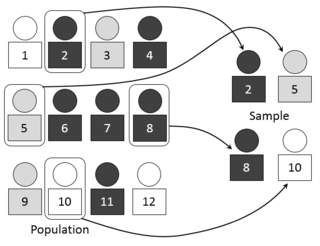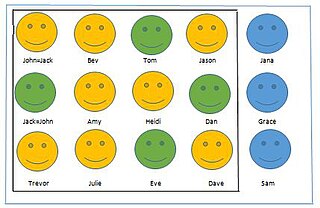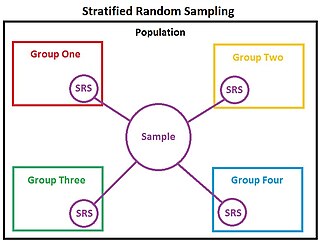 W
WIn statistics, quality assurance, and survey methodology, sampling is the selection of a subset of individuals from within a statistical population to estimate characteristics of the whole population. Statisticians attempt for the samples to represent the population in question. Two advantages of sampling are lower cost and faster data collection than measuring the entire population.
 W
WA census is the procedure of systematically enumerating, and acquiring and recording information about the members of a given population. This term is used mostly in connection with national population and housing censuses; other common censuses include agricultural, traditional culture, business, supplies, and traffic censuses. The United Nations defines the essential features of population and housing censuses as "individual enumeration, universality within a defined territory, simultaneity and defined periodicity", and recommends that population censuses be taken at least every ten years. United Nations recommendations also cover census topics to be collected, official definitions, classifications and other useful information to co-ordinate international practices.
 W
WCoin flipping, coin tossing, or heads or tails is the practice of throwing a coin in the air and checking which side is showing when it lands, in order to choose between two alternatives, heads or tails, sometimes used to resolve a dispute between two parties. It is a form of sortition which inherently has two possible outcomes. The party who calls the side that the coin lands on wins.
 W
WCoverage error is a type of non-sampling error that occurs when there is not a one-to-one correspondence between the target population and the sampling frame from which a sample is drawn. This can bias estimates calculated using survey data. For example, a researcher may wish to study the opinions of registered voters by calling residences listed in a telephone directory. Undercoverage may occur if not all voters are listed in the phone directory. Overcoverage could occur if some voters have more than one listed phone number. Bias could also occur if some phone numbers listed in the directory do not belong to registered voters. In this example, undercoverage, overcoverage, and bias due to inclusion of unregistered voters in the sampling frame are examples of coverage error.
 W
WItem tree analysis (ITA) is a data analytical method which allows constructing a hierarchical structure on the items of a questionnaire or test from observed response patterns. Assume that we have a questionnaire with m items and that subjects can answer positive (1) or negative (0) to each of these items, i.e. the items are dichotomous. If n subjects answer the items this results in a binary data matrix D with m columns and n rows. Typical examples of this data format are test items which can be solved (1) or failed (0) by subjects. Other typical examples are questionnaires where the items are statements to which subjects can agree (1) or disagree (0). Depending on the content of the items it is possible that the response of a subject to an item j determines her or his responses to other items. It is, for example, possible that each subject who agrees to item j will also agree to item i. In this case we say that item j implies item i. The goal of an ITA is to uncover such deterministic implications from the data set D.
 W
WA kleroterion was a randomization device used by the Athenian polis during the period of democracy to select citizens to the boule, to most state offices, to the nomothetai, and to court juries.
 W
WA lottery machine is the machine used to draw the winning numbers for a lottery.
 W
WThe margin of error is a statistic expressing the amount of random sampling error in the results of a survey. The larger the margin of error, the less confidence one should have that a poll result would reflect the result of a survey of the entire population. The margin of error will be positive whenever a population is incompletely sampled and the outcome measure has positive variance, which is to say, the measure varies.
 W
WOdds and evens is a simple game of chance and hand game, involving two people simultaneously revealing a number of fingers and winning or losing depending on whether they are odd or even, or alternatively involving one person taking picking up coins or other small objects and hiding them in their closed hand, while another player guesses whether they have an odd or even number. The game may be used to make a decision or played for fun.
 W
WAn opinion poll, often simply referred to as a poll or a survey, is a human research survey of public opinion from a particular sample. Opinion polls are usually designed to represent the opinions of a population by conducting a series of questions and then extrapolating generalities in ratio or within confidence intervals. The person who conducts polls is referred to as Pollster.
 W
WRock paper scissors is a hand game usually played between two people, in which each player simultaneously forms one of three shapes with an outstretched hand. These shapes are "rock", "paper", and "scissors". "Scissors" is identical to the two-fingered V sign except that it is pointed horizontally instead of being held upright in the air.
 W
WIn statistics and quantitative research methodology, a sample is a set of individuals or objects collected or selected from a statistical population by a defined procedure. The elements of a sample are known as sample points, sampling units or observations. When conceived as a data set, a sample is often denoted by capital roman letters such and , with its elements expressed in lower-case and the sample size denoted by the letter .
 W
WStock sampling is sampling people in a certain state at the time of the survey. This is in contrast to flow sampling, where the relationship of interest deals with duration or survival analysis. In stock sampling, rather than focusing on transitions within a certain time interval, we only have observations at a certain point in time. This can lead to both left and right censoring. Imposing the same model on data that have been generated under the two different sampling regimes can lead to research reaching fundamentally different conclusions if the joint distribution across the flow and stock samples differ sufficiently.
 W
WIn statistics, stratified randomization is a method of sampling which first stratifies the whole study population into subgroups with same attributes or characteristics, known as strata, then followed by simple random sampling from the stratified groups, where each element within the same subgroup are selected unbiasedly during any stage of the sampling process, randomly and entirely by chance. Stratified randomization is considered a subdivision of stratified sampling, and should be adopted when shared attributes exist partially and vary widely between subgroups of the investigated population, so that they require special considerations or clear distinctions during sampling. This sampling method should be distinguished from cluster sampling, where a simple random sample of several entire clusters is selected to represent the whole population, or stratified systematic sampling, where a systematic sampling is carried out after the stratification process. Stratified random sampling is sometimes also known as "stratified random sampling" or "quota random sampling".
 W
WIn statistics, stratified sampling is a method of sampling from a population which can be partitioned into subpopulations.
 W
WSufficient similarity is a 20th-century para-legal concept used in the chemical industry for toxicological studies. The term was first employed in a restricted sense to assess surrogacy of chemical mixtures by the EPA, and has descended from there into the scientific argot.